Smog hazards are back with the winter

- 280
- 0
Respiratory diseases, itchy eyes and breathing problems have become common complaints among a section of citizens of Lahore with the advent of cold weather marked by dense smog which has become an annual feature in the Punjab province.
In fact, smog has reached a level that the capital city of Lahore was declared as the most polluted city in the world last month. Not only health issues are on the rise, traffic incidents are also reported due to smog. Last year, 363 deaths were reported in road accidents during the smog phases i.e. in November and the same is feared this years. The citizens have been asked to be extremely cautious and careful while driving on the Lahore roads during the deteriorating air pollutions in the country's second biggest city. To be very specific, it is a sort of horrible air pollution which turns into public health emergency in winter in Punjab , particularly the Lahore city, which is experiencing this menace since 2011 but despite the a decade of sufferings by the people, the Govt has miserably failed to form a strategy to avert this yearly crisis. As the mid of November approaches, the citizens of Lahore become more vulnerable to respiratory ailments and chest infections. The irony is that there is full-fledged Climate Ministry but with no clear cut policies and comprehensive strategies on how to work to fight out the smoggy dangers.
According to air pollution data released by the US Air Quality Index, Lahore is on top of the list of most polluted cities in the world with the worst harmful air quality levels. Even India's Delhi and Kolkata come after Pakistan and a placed at third and fourth while Karachi is the fifth city Lahore showed a particulate matter (PM) rating of over 300 due to which the city in included in the "hazardous" category of air quality. Different areas of Lahore fared worse. The Kot Lakhpat (industrial area) crossed over 400, with Fatehgarh housing most of the steel melting industry, and other areas near 400 AQI. The Provincial Disaster Management Authority (PDMA) instead of doing something concrete to mitigate the sufferings of Lahori's only released a monthly report recently about its steps to control smog. And its activities as seen from its report are just to collect Rs38 million fine from different sectors which is not a solution. The Pakistan Environmental Protection Agency (Pak-EPA) and other related organizations have also miserably failed to form a comprehensive strategy in this hazardous matter. Such smog has also been impacting the economy of the affected region but there is a need for climate activism from the civil society too, which has not been as proactive in Pakistan as it should have been.
Experts say that Air pollution has worsened in the country in recent years due to a number of factors including a mixture of low-grade diesel fumes, smoke from industrial units crop burn off, and colder winter temperatures coalesce into stagnant clouds of smog. Besides, India is also responsible for smog menace in Lahore as the India burning of fuels, smoke from vehicular and plants emissions, explosive material used near Pakistan border by India, burning of rice stubbles that send smog across the border to Lahore. It has also been noticed that after Diwali, Lahore experiences greater hazards smog every year. The purpose to say is that smog is not a natural phenomenon but a man-made hazard and it needs multiple strategies at national and regional levels to control it. Though the government has been making hue and cry over climate change effects and is also introducing some measures for environmental conservation, but it is totally oblivious to the menace of smog.
The outcome of this lackluster approach in containing smog is more perils for the economy and for the citizens who are facing a lot of difficulties in performing their routine tasks. The smog menace has reached a level where one advise the govt to set up a special commission or tribunal to investigate the grave issue and come up with urgent actions on war footing level. It has been noticed that some industries are opening violating the environmental regulations such as brick kiln factories and the burning of stubble in fields in Punjab.
Not only the air level is hazardous in Punjab, the riverbeds and surrounding spots are also polluted due to which the wetlands have destroyed and greenery is vanishing. In a nutshell, all living things including plants and animals are also at risk due to smog but both the Federal and Punjab govt are deep in slumber and need to be awakened to this serious hazard. As a matter of fact, smog has become a routine yearly menace. It not only causes road accidents but due this extreme sort of air pollution, the masses of these areas are developing chest and lung diseases; their livelihood and economic activities are also suffering but the govt is totally oblivious to the dangers of smog. In Punjab, particularly its capital city Lahore, the choking hazard, with the smell of smog, has reached an alarming level and health practitioners have advised the citizens to use masks to avoid health hazards air pollution that is seeping into homes in and around the capital city. The well-do-people are buying air purifiers but the low income people are at greater risk as they cannot afford the safety measures. Children and the elderly at greater risk and doctors have advised them to stay indoors at critical hours when smog is dense. The sad fact is it is a sort of horrible air pollution which turns into public health emergency in winter in Punjab , particularly the Lahore city, which is experiencing this menace since 2011 but despite the a decade of sufferings by the people, the Govt has miserably failed to form a strategy to avert this yearly danger. As the mid of winter approaches, the citizens of Lahore become more vulnerable to respiratory ailments and chest infections. The irony is that there is full-fledged Climate Ministry but with no clear cut policies and comprehensive strategies on how to work to fight out the smog.
Published in The Daily National Courier, November, 29 2022
Like Business on Facebook, follow @DailyNCourier on Twitter to stay informed and join in the conversation.

















































